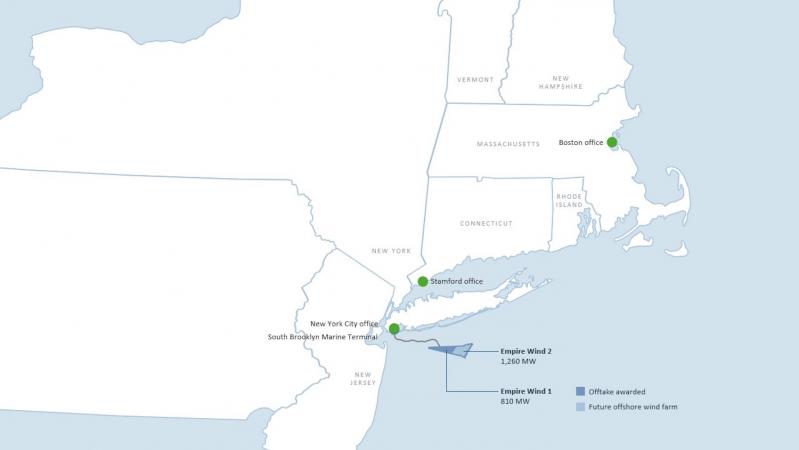The future of offshore wind power in New York State and throughout the United States was thrown into question last week as the Trump administration’s interior secretary ordered a halt to construction of the 810-megawatt Empire Wind 1 project, which was to span 80,000 acres in the New York Bight and send renewable electricity to New York City.
The April 16 order, which published reports say came at the urging of Representatives Chris Smith and Jeff Van Drew of New Jersey and with the support of Nassau County Executive Bruce Blakeman, followed an executive order on Jan. 20, the day President Trump took office, indefinitely withdrawing all areas on the Outer Continental Shelf from offshore wind leasing and ordering a review of the federal government’s leasing and permitting practices for wind projects.
The order “temporarily prevents consideration of any area in the O.C.S. for any new or renewed wind energy leasing for the purposes of generation of electricity or any other such use derived from the use of wind.” It does not apply to leasing related to the extraction of oil, gas, or minerals.
The president is concurrently canceling funding for environmental protections and boosting use of fossil fuels including coal, considered the dirtiest form of energy because of the greenhouse gases, mercury, and particulate matter emitted when it is burned. The president misrepresented its safety and use in announcing four executive orders aimed at boosting the mining of coal, which has been declining for decades.
During his confirmation hearings, Doug Burgum, the interior secretary, told senators that the United States was facing an energy crisis, despite the U.S. Energy Information Administration’s 2024 report that the country had produced more crude oil than any nation at any time for six consecutive years. In January The New York Times noted his “longstanding ties to oil and gas executives.”
Onshore construction of the fully permitted, 54-turbine Empire Wind 1 began a year ago with work on its transmission infrastructure and the South Brooklyn Marine Terminal. Offshore construction began in July, and installation of the wind turbine generators was to begin in September.
“We will engage directly with [the federal Bureau of Ocean Energy Management] and the Department of Interior to understand the questions raised about the permits we have received from authorities,” an Equinor spokesman said in an April 16 statement provided to The Star. “We will not comment about the potential consequences until we know more.”
“The construction phase has put more than 1,500 people to work” in the United States, the Norwegian energy company noted in a statement issued last Thursday. “Empire Wind 1 has the potential to power 500,000 New York homes.”
State officials and renewable-energy advocates denounced the move and urged its reversal. “Empire Wind 1 is already employing hundreds of New Yorkers, including 1,000 good-paying union jobs, as part of a growing sector that has already spurred significant economic development and private investment throughout the state and beyond,” Gov. Kathy Hochul said in an April 16 statement. “This fully federally permitted project has already put shovels in the ground before the president’s executive orders — it’s exactly the type of bipartisan energy solution we should be working on.”
“As governor,” she continued, “I will not allow this federal overreach to stand.”
Rory M. Christian, chief executive officer of the New York State Department of Public Service, said in a statement last Thursday that the federal action is hypocritical and harmful. The president “has declared an energy crisis,” he wrote. “Preventing the construction and operation of this thoroughly and carefully reviewed offshore wind project runs counter to that determination.”
In a statement provided to The Star, the Alliance for Clean Energy New York said that “the fully permitted Empire Wind 1 project went through years of rigorous environmental review and has already invested hundreds of millions in New York’s economy. Today’s directive is antithetical to the Trump administration’s goal of expanding American energy production and will instead increase reliance on imported energy. It will also halt job creation and economic development in New York while undermining grid reliability.”
A spokeswoman for Orsted, developer of the 12-turbine South Fork Wind farm, which has been operating in a federal lease area about 30 miles off Montauk Point for more than a year, as well as the five-turbine Block Island Wind farm, and has several other installations planned, declined to comment on the executive order.
The Long Island Power Authority, which approved the South Fork Wind farm in 2017 to meet growing electricity demand on the South Fork, issued a fact sheet stating that “in its first year of operation, South Fork Wind has proven that offshore wind is a reliable and dependable energy source.” A graph depicts monthly production including around 55,000 megawatt hours in both November and January, and around 45,000 megawatt hours produced in December and February. LIPA further notes that the project has created nearly 1,000 jobs across five states and includes components manufactured in the United States.
But Bonnie Brady, executive director of the Long Island Commercial Fishing Association and a critic of offshore wind, said on Monday that she is “cautiously optimistic” about the halt to construction. “I was really excited at first when I heard,” she said, “but this has been a battle for so long that I will take every pause that we can get, so that all of the information that needs to be made public and that the administration can be aware of exists, so that things are done properly.”
Fisheries should be involved in the review of leasing and permitting practices for wind projects, she said. “I really hope the administration makes the effort to speak with those of us that have been battling these for a long time,” so that opponents of offshore wind can “give them a plethora of information so they can do a complete and thorough review.”
Wind farms’ proponents cite union jobs created, but “what about our jobs?” she asked. “Not just the men who own the boats — it’s the ports, the coastal communities. They’re basically taking the entire coastline from Massachusetts to North Carolina, taking those communities and just trashing them, destroying them in effect.”
Melissa Parrott, executive director of Renewable Energy Long Island, disagrees. “ ‘Disappointed’ would be a word that we would use,” she said on Monday. “We were optimistic that Trump would understand the value of the U.S.-generated energy that he speaks so much of, and how we’d capture that right off the coast of Long Island and it would power the thousands and thousands of homes.”
Hers and other advocacy groups will now “get loud,” she said, referring to a campaign to inform and educate the public as to offshore wind and to counter misinformation — “that’s the biggest thing we’re up against now.”
Utilities “are really moving forward well with this clean energy transition, and this momentum is going to be real hard to stop,” Ms. Parrott said, but “clearly we’re hitting an area where it’s pausing. The goal is to keep working with the utilities, with Governor Hochul, with our congressmen on keeping the benefits to their constituents and residents of Long Island in mind.”
Renewable Energy Long Island took part in a rally at the Nassau County Legislature on Tuesday, which Ms. Parrott said stemmed from Mr. Blakeman’s denunciation of Empire Wind 1. The strategy, she said, is “to fight back and have our own press conference, our own ability to share with the general public facts, science, and benefits, and to be as loud as them in fighting this misinformation.”
But for Ms. Brady, “Best-case scenario, they will rightfully get rid of them all,” she said of offshore wind farms. “I don’t want to see the ocean turned into an industrial wasteland.”




